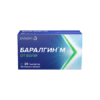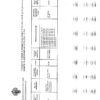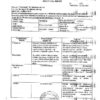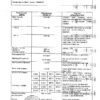No products in the cart.
Baralgin M, tablets 500 mg 20 pcs
€7.97 €6.64
Description
Pharmacological action – antispasmodic, analgesic, antipyretic, anti-inflammatory.
Blocks cyclooxygenase and reduces GH synthesis.
Pharmacokinetics
. After oral administration, it is hydrolyzed in the gastrointestinal tract to form the active metabolite, 4-methylaminoantipyrine (4-MMA), which is absorbed in the liver to 4-aminoantipyrine (4-AA), as well as pharmacologically inactive metabolites. After ingestion of 1 g of metamizole, 58% of 4-MMA and 48% of 4-AA are bound to plasma proteins.
The effective therapeutic plasma concentration of 4-MMA is reached in 20-40 min, Cmax – in 2 h.
Indications
Indications
Active ingredient
Active ingredient
Composition
Composition
How to take, the dosage
How to take, the dosage
In tablets, 1-2 tablets are prescribed for adults. Baralgin up to 4 times a day.
The maximum daily dose is not more than 8 tablets.
Interaction
Interaction
With cyclosporine
Sodium metamizole may decrease the serum concentration of cyclosporine, therefore, when using them together cyclosporine concentrations should be monitored.
With other non-narcotic analgesic agents
Simultaneous use of sodium metamizole with other non-narcotic analgesic agents may result in mutually reinforcing toxic effects.
With tricyclic antidepressants, oral contraceptives, allopurinol
Tricyclic antidepressants, oral contraceptives, allopurinol impair metabolism of sodium metamizole in the liver and increase its toxicity.
With barbiturates, phenylbutazone and other inducers of microsomal liver enzymes
Barbiturates, phenylbutazone and other inducers of microsomal liver enzymes weaken the effects of sodium metamizole.
With sedatives and tranquilizers
Sedatives and tranquilizers increase the analgesic effect of sodium metamizole. Severe hypothermia may develop if sodium metamizole and chlorpromazine are used concomitantly.
With medicinal products with high protein binding (oral hypoglycemic agents, indirect anticoagulants, glucocorticosteroids and indomethacin)
. Metamizole sodium displaces oral hypoglycemic agents, indirect anticoagulants, glucocorticosteroids and indomethacin from binding to plasma proteins and enhances their effects.
With myelotoxic drugs
Myelotoxic drugs increase the manifestation of hematotoxicity of sodium metamizole.
With methotrexate
The addition of sodium methamisole to methotrexate treatment may increase the hematotoxic effects of methotrexate, especially in elderly patients.
This combination should therefore be avoided.
With thiamazole and sarcolysin
Thiamazole and sarcolysin increase the risk of leukopenia.
With codeine, H2-histamine receptor blockers and propranololol
Codeine, H2-histamine receptor blockers and propranololol increase the effects of sodium metamizole.
Rentgen contrast agents, colloidal blood substitutes and penicillin should not be used during treatment with sodium metamizole (increased risk of anaphylactic/anaphylactoid reactions).
With acetylsalicylic acid
When used together, sodium metamizole may decrease the effect of acetylsalicylic acid on platelet aggregation. Therefore, this combination should be used with caution when treating patients taking low doses of acetylsalicylic acid for cardioprotection (prevention of thrombosis). With bupropion
Sodium metamizole may decrease the blood concentration of bupropion, which should be taken into account when using metamizole sodium and bupropion concomitantly.
Special Instructions
Special Instructions
In patients suffering from bronchial asthma, taking this drug may provoke a seizure.
Contraindications
Contraindications
Side effects
Side effects
Overdose
Overdose
Symptoms
The following symptoms may occur in overdose: nausea, vomiting, abdominal pain, decreased renal function/acute renal failure with oliguria (e.g., due to the development of interstitial nephritis), more rarely symptoms of the central nervous system (dizziness, drowsiness, tinnitus, delirium, impaired consciousness, coma, seizures) and a sharp decrease in blood pressure (sometimes progressing to shock), as well as cardiac rhythm disorders (tachycardia), hypothermia, shortness of breath, acute agranulocytosis, hemorrhagic syndrome, acute liver failure, respiratory muscle paralysis. After high doses, excretion through the kidneys of the non-toxic metabolite (rubazonic acid) may cause red staining of the urine.
Treatment
If no more than 1-2 hours have passed after taking the drug, it is possible to induce vomiting, gastric lavage through a tube; give saline laxatives, activated charcoal. In case of overdose, forced diuresis is indicated. The main metabolite (4-N-methylaminoantipyrine) may be excreted by hemodialysis, hemofiltration, hemoperfusion or plasma filtration. If seizure syndrome develops, intravenous administration of diazepam and fast-acting barbiturates.
Pregnancy use
Pregnancy use
Baralgin M is contraindicated in pregnant women, nursing mothers and children in the first three months of life.
Similarities
Similarities
Additional information
| Shelf life | 4 years |
|---|---|
| Conditions of storage | In a light-protected place, at 8-25 °C |
| Manufacturer | Zentiva Private Limited, India |
| Medication form | pills |
| Brand | Zentiva Private Limited |
Related products
Buy Baralgin M, tablets 500 mg 20 pcs with delivery to USA, UK, Europe and over 120 other countries.






















